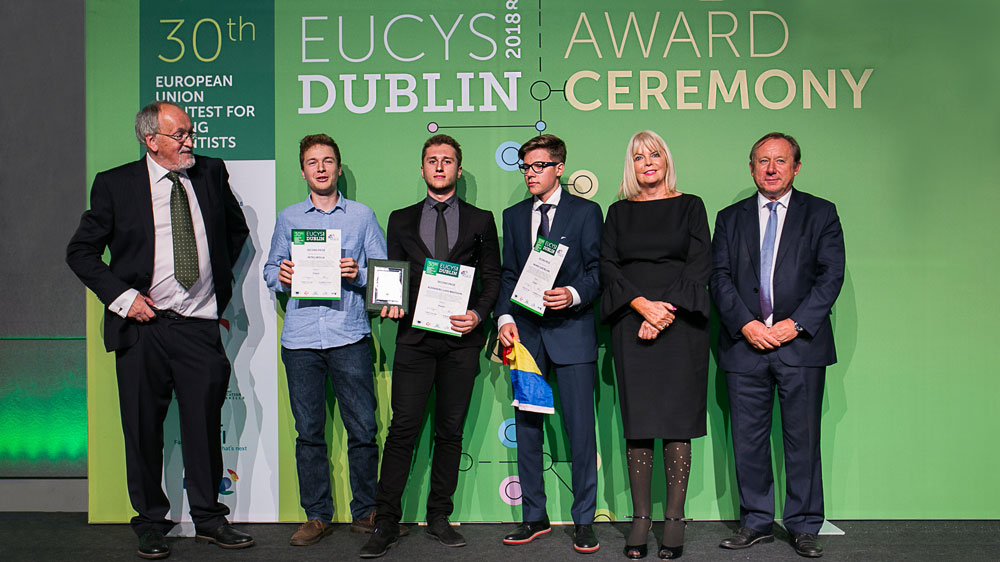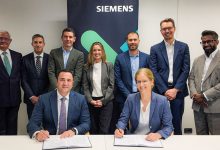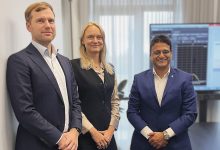3 Romanian young scientists won the 2nd prize at EUCYS
The EU Contest for Young Scientists (EUCYS) is an initiative of the European Commission under the Science and Society programme. It was set up to promote the ideals of cooperation and information exchange between young scientists.
The contest is held each year in a different European city. The 2018 contest was held in Dublin, Ireland from 14 to 19 September.
450 million 1TB hard disks, stored in 1g of DNA, all at a maintenance rate of around 10€ a year – is the digital storage proposal by Alexandru Liviu Bratosin (17 years), Petru Molla (17 years), Mihnea Vlad Bojian (18 years), students at Lycée Français Anna de Noailles, Bucharest.
The project called ‘DNAdrive’ brought them the second place in the competition. The main goal was to create a safer and more extensive digital data storage alternative. By exploiting the immune system of a certain bacterial strain, the students managed to write information in bacterial genome, encoded by a home-cooked conversion algorithm.
This year’s European Union’s top prizes for young scientists were awarded to siblings Adrian Fleck and Anna Amelie Fleck from Germany for ‘FleckProtec – Body Protection Made from Starch’, Nicolas Fedrigo from Canada for ‘Improving Spinal Fusions: Redesigning the Pedicle Probe to Prevent Vertebral Breaches’, and Brendon Matusch from Canada for ‘Development of a Level 2 Autonomous Vehicle Using Convolutional Neural Networks and Reinforcement Learning’. The winning young scientists will receive €7000 for each of the three outstanding projects.
The winners were among 135 promising young scientists aged 14 to 20 from 38 countries and the European schools. They presented a total of 88 projects at the 30th edition of the EU Contest for Young Scientists over the last few days in Dublin, Ireland, in the hope of impressing an international jury. All the winners shared a total of €57.500 in prize money, as well as other prizes such as science trips.
Carlos Moedas, Commissioner for Research, Science and Innovation, stated: “I warmly congratulate the winners of this year’s contest on their fantastic achievement. It’s encouraging to see so much talent in these young researchers and innovators. They are our future – with their ground-breaking discoveries and innovations that are no doubt to come, we will be able to better tackle the great challenges and ensure our prosperity and well-being.”
This year’s winners received their prizes from the Irish Minister of Higher Education Mary Mitchell O’Connor and Wolfgang Burtscher, the Commission’s Deputy Director General for Research and Innovation. The jury was chaired by Professor Tony Fagan from University College Dublin.
The participants had all previously won first prizes in their home countries’ national science competitions in their specific fields. The projects covered a broad spectrum of scientific areas, including biology, physics, chemistry, computing, social sciences, environment, mathematics, materials, engineering and medicine.
Non-cash prizes included trips to the London International Youth Science Forum and the Stockholm International Youth Science Seminar as well as prizes from corporate sponsors including trips to Intel ISEF in the US. They also consist of educational visits to the European Commission’s in-house science service, the Joint Research Centre, and the eight organisations making up the pan-European research group EIROforum. The food industry donated four awards and the Bio-based industry also awarded a prize. Other awards were donated by PRACE supercomputing, the Salvetti Foundation, EuChemS, Bulgarian Mathematics Summer School and the Swiss Talent Forum. There were also several host country prizes on offer.
Background
The European Union Contest for Young Scientists was set up by the European Commission in 1989 to encourage co-operation and exchange between young scientists and to give them an opportunity to be guided by some of Europe’s most prominent researchers.
The contest seeks to support national efforts to attract young people to study science, technology, engineering and maths (STEM), and to eventually choose careers in science and research. The number of participating young scientists has grown from 53 in the first competition in 1989 to an average of 150 a year.
Female participation in the contest reflects the broader issue of underrepresentation of women in STEM. This year, 41% of the participants were female (55 girls vs. 79 boys) and 41% of winners were female.







